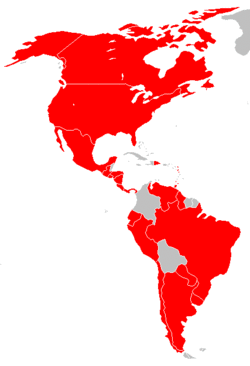Inter-American Convention Against Terrorism
Appearance
| Inter-American Convention Against Terrorism | |
|---|---|
 Parties to the treaty | |
| Signed | 3 June 2002 |
| Location | Bridgetown,Barbados |
| Effective | 6 July 2003 |
| Condition | 6 ratifications |
| Signatories | 33 |
| Parties | 24 |
| Depositary | General Secretariat of theOrganization of American States |
| Languages | English, French, Portuguese, and Spanish |
TheInter-American Convention Against Terrorismwas adopted by the member countries of theOrganization of American States(OAS) at itsGeneral Assemblyheld inBridgetown,Barbados,on 3 June 2002. The convention, negotiated pursuant to a mandate from the OAS Foreign Ministers shortly after the terrorist attacks of11 September 2001in theUnited States,reflects theAmericas' hemispheric-wide commitment to enhancing cooperation in the fight againstterrorism.
In brief, the convention:
- Improves regional cooperation in the fight against terrorism, thereby enhancing hemispheric security.
- Commits parties to endeavor to sign and ratify the relevant U.N. anti-terrorism instruments (a major element inU.N. Security Council Resolution 1373).
- Commits parties to use the recommendations of theFinancial Action Task Force(FATF) and other specialized entities as guidelines in taking measures to prevent, combat and eradicate the financing of terrorism.
- Denies safe haven to suspected terrorists, both as refugees and asylum-seekers, and denies use of thepolitical offense exceptionby suspected terrorists to prevent extradition or rendering of mutual legal assistance.
- Extends the terrorist acts covered under the relevant U.N. anti-terrorism instruments tofinancial crimes(e.g., money laundering) and other provisions of the U.N.'sConvention Against Transnational Organized Crime.The OAS Convention thus elaborates for regional use a variety of legal tools that have proven effective againsttransnational organized crimein recent years.
- Enhances cooperation in a number of areas, including: exchanges of information on border control measures and law enforcement actions; appointment of a single national point of contact as liaison with other states and relevant bodies; exchanges of experience and training; technical assistance; and mutual legal assistance.
- Demonstrates regional solidarity in fight against terrorism.
- Facilitates the implementation of a number of the mandates in U.N. Security Council Resolution 1373 and expands the signatory states' ability to act upon some of the recommendations set forth in the Resolution.
To date[update],the convention has been signed by 33 of the 34 active member states and ratified by 24.
Convention oversight is the task of the OAS'sInter-American Committee Against Terrorism.
Sources
[edit]- The original version of this article was in part adapted fromInter-American Convention Against Terrorism,apublic domainpublication of theUnited States government.
External links
[edit]Categories:
- Terrorism treaties
- Organization of American States treaties
- Treaties concluded in 2002
- Treaties entered into force in 2003
- Treaties of Antigua and Barbuda
- Treaties of Argentina
- Treaties of Brazil
- Treaties of Canada
- Treaties of Chile
- Treaties of Colombia
- Treaties of Costa Rica
- Treaties of Dominica
- Treaties of the Dominican Republic
- Treaties of Ecuador
- Treaties of El Salvador
- Treaties of Grenada
- Treaties of Guatemala
- Treaties of Guyana
- Treaties of Honduras
- Treaties of Mexico
- Treaties of Nicaragua
- Treaties of Panama
- Treaties of Paraguay
- Treaties of Peru
- Treaties of Trinidad and Tobago
- Treaties of the United States
- Treaties of Uruguay
- Treaties of Venezuela
- 2002 in Barbados
